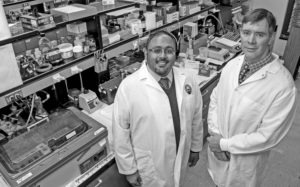
Two University of Montana researchers were among six final winners nationally to receive $500,000 from the Head Health Challenge I, an up-to-$10 million program sponsored by General Electric Co. and the National Football League.
UM Research Assistant Professors Tom Rau of Hamilton and Sarj Patel of Missoula, whose work aims to speed diagnosis and improve treatment for mild traumatic brain injury, received the news this week.
The goal of the Head Health Challenge is to improve the safety of athletes, members of the military and society overall. The winners were selected from an initial group of 16 challenge winners who were chosen from more than 400 entries from 27 countries, after having been reviewed and nominated by a panel of leading health care experts in brain research, imaging technologies and advocates for advances in brain research.
As part of the initial group, the UM research team was awarded $300,000 in 2014. For the past year, they were provided mentorship and access to GE researchers and industry leaders.
Other projects were selected from both biotechnology companies and leading research institutions, including Banyan Biomarkers, Inc., BrainScope Company, Inc., Medical College of Wisconsin, Quanterix and the University of California, Santa Barbara.
Rau and Patel conduct research at UM’s Department of Biomedical and Pharmaceutical Sciences in the Skaggs School of Pharmacy. Their team, which includes senior staff scientists Diane Brooks, Eric Wohlgehagen and Fred Rhoderick, are working to discover blood-based biomarkers that indicate how the brain reacts following a traumatic brain injury. The first phases of their research, which were initially funded by a University Grant Program award at UM, then the Missoula-based Montana Neuroscience Institute and the state-based Montana Board of Research & Commercialization Technology, have shown that TBI results in changes in how the brain operates and in levels of proteins and micro-ribonucleic acids. Identifying specific biomarkers will show how TBI changes the brain and could help doctors with diagnosis and treatment.
The first award allowed the researchers to immediately begin identifying injury biomarkers occurring in the brains of athletes or military personnel. Patel said they collected blood samples from people who suffered from a TBI to see if they could detect the molecules and ultimately determine how long it might take for them to return to play or service.
“The first award really got our human testing off the ground,” Rau said. “We had a good body of animal research, but the Head Health Challenge I award gave us the funding to confirm that the biomarkers are present in human plasma following injury.”
The researchers collaborated with UM’s Department of Athletics to collect samples from UM football and soccer athletes. They worked closely with UM Head Athletic Trainer J.C. Weida to draw blood from the players.
“It’s been a really great relationship, and we plan to continue working with J.C. into the next phase of our research,” Rau said.
The current $500,000 award will allow for expanded testing that aims to clinically validate the research. In addition to their work on TBI, Rau and Patel plan to use samples obtained from the human brain bank at the Center for the Study of Traumatic Encephalopathy at Boston University, which includes brains from deceased patients, to take their testing one step further and look for biomarkers of chronic traumatic encephalopathy, a progressive and degenerative disease of the brain found in people with a history of repetitive brain trauma.
“That’s part of what got us the second award,” Rau said. “We took our research one step further and gave them more than what we said we were going to do.”
He said the research may help solve the mystery of why a localized brain injury causes damage throughout the entire brain. Because proteins work in the body as transporters and catalysts, a disruption in one area could cause farther-reaching problems.
Launched in March 2013, the Head Health Challenge is part of the Head Health Initiative, a four-year, $60 million collaboration between GE and the NFL. The initiative includes a $40 million research and development program from the NFL and GE to evaluate and develop next-generation imaging technologies to improve diagnosis that would allow for targeting treatment therapy for patients with mild traumatic brain injury.
For more information on the Head Health Challenge, visit http://www.headhealthchallenge.com. For more information on the research happening at UM, call Patel at 406-243-5876 or email sarjubhai.patel@umontana.edu or call Rau at 406-529-7916 or email thomas.rau@umontana.edu.
